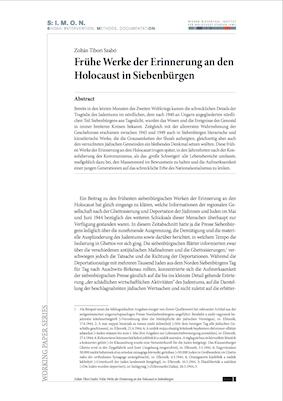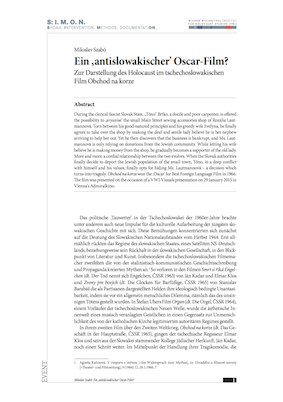 The terrible details of the tragedy of Jewry in the northern part of Transylvania, which had been annexed to Hungary after 1940, emerged even in the last months of the Second World War, when the essence and events of the genocide were known in ever wider circles. As awareness of the events first emerged, literary and artistic works were also published in Transylvania between 1945 and 1949 that depicted the cruelties of the Shoah and at the same time aimed to raise a lasting monument for the Jewish communities that had been destroyed. These early works of Holocaust remembrance made a considerable contribution to retaining the mass murder in people's consciousness and turning a young generation's awareness to the terrible heritage of Nazism later on, when, during the decades of consolidation of communism, all spheres of life were submerged in a “great silence”.
The terrible details of the tragedy of Jewry in the northern part of Transylvania, which had been annexed to Hungary after 1940, emerged even in the last months of the Second World War, when the essence and events of the genocide were known in ever wider circles. As awareness of the events first emerged, literary and artistic works were also published in Transylvania between 1945 and 1949 that depicted the cruelties of the Shoah and at the same time aimed to raise a lasting monument for the Jewish communities that had been destroyed. These early works of Holocaust remembrance made a considerable contribution to retaining the mass murder in people's consciousness and turning a young generation's awareness to the terrible heritage of Nazism later on, when, during the decades of consolidation of communism, all spheres of life were submerged in a “great silence”.
Editorial
 S:I.M.O.N. is an e-journal of the Vienna Wiesenthal Institute for Holocaust Studies (VWI). It appears twice a year in English and German language. S:I.M.O.N. aims at both a transnational and comparative history of the Holocaust and Jewish Studies in Central and Eastern Europe within the broader contexts of the European history of the 20th and 21st century, including its prehistory, consequences and legacies as well as the history of memory.
S:I.M.O.N. is an e-journal of the Vienna Wiesenthal Institute for Holocaust Studies (VWI). It appears twice a year in English and German language. S:I.M.O.N. aims at both a transnational and comparative history of the Holocaust and Jewish Studies in Central and Eastern Europe within the broader contexts of the European history of the 20th and 21st century, including its prehistory, consequences and legacies as well as the history of memory.
S:I.M.O.N. serves as a forum for discussion of various methodological approaches. The journal especially wishes to strengthen the exchange between researchers from different scientific communities and to integrate both the Jewish history and the history of the Holocaust into the different “national” narratives. It also lays a special emphasis on memory studies and the analysis of politics of memory. S:I.M.O.N. uses a double-blind review system, which means that both the reviewer’s and the author’s identities are concealed from each other hroughout the review process.
Shoah: The journal deals with the history of the Shoah from multidisciplinary, transnational and comparative perspectives. It seeks to integrate studies on Jews as well as on other groups of victims of the Holocaust, especially on Roma, and of so far less researched regions of (East) Central and (South) Eastern Europe.
Intervention. The journal reports on research projects and their transmission into public events. It also informs about current educational and remembrance programs.
Methods. The journal serves as a forum for the discussion of methodological approaches as, for instance, the everyday history, oral history, gender history, the history of violence, anti-Semitism and racism and the theory of memory and memory politics.
DocumentatiON. The journal contributes to critical approaches on using and interpreting archival materials in the 21st century.
Download the current issue S:I.M.O.N. 2017/2.
Articles
Gerhard Baumgartner
The Road Towards Genocide. The Process of Exclusion and Persecution of Roma and Sinti in the 1930s and 1940s
 The fate of the European Roma during the Holocaust, the murder of several hundreds of thousands of Roma and Sinti in the territories under control of the Third Reich – a genocide which by Roma and Sinti representatives is also referred to as 'Porrajimos' or 'Samusdripen' – now forms an accepted part of European historical discourse on the 20th century and has become the focal point of a new Europe-wide process of Roma identity formation. In its monstrosity and unprecedented brutality it is like a vast shadow cast upon the common history of Roma and Gadje alike, a memento of an unspeakably dehumanised past.
The fate of the European Roma during the Holocaust, the murder of several hundreds of thousands of Roma and Sinti in the territories under control of the Third Reich – a genocide which by Roma and Sinti representatives is also referred to as 'Porrajimos' or 'Samusdripen' – now forms an accepted part of European historical discourse on the 20th century and has become the focal point of a new Europe-wide process of Roma identity formation. In its monstrosity and unprecedented brutality it is like a vast shadow cast upon the common history of Roma and Gadje alike, a memento of an unspeakably dehumanised past.
Historians have reconstructed the events that culminated in these murderous acts in great detail, mapping the increasingly radical acts of marginalisation and persecution of people labelled as 'Zigeuner' ('Gypsies') by the authorities. This marginalisation started during the Romantic period, when Europeans were told to see 'Gypsies' as fundamentally different and exotic – the 'last savages of Europe'. This, combined with the emerging 'science' of eugenics, which declared these differences to be genetically determined and therefore immutable, prepared the ground for their marginalisation and exclusion from society, based on pseudoscientific concepts.
A severe social crisis caused by the global economic crisis of the 1930s, aggravated by the lack of adequate social welfare systems in Central and Eastern Europe at the time, led to clashes between the Roma and non-Roma populations, especially in the formerly Hungarian, now Austrian, Burgenland region. This later provided the justification for the Nazi administration's racist policies against Roma and Sinti, which eventually culminated in genocide. Some key ingredients in this catastrophe may seem strangely familiar now, as we can again encounter them in Europe today. Looking at the policies that paved the way for the Nazi genocide of the 'Gypsies', it becomes clear that many of today's policies and administrative practices affecting Roma, especially in Eastern Europe, are not that new after all and have worrying echoes in the past.
SWL-Reader
Nóra Berend
Jews and the Hungarian State. Integrative and Exclusionary Models from Medieval to Modern Times
 In Hungary, official memory and history discourses often distinguish between ‘Jews’ and ‘Hungarians’, harking back to the Horthy-era concept of the ‘Christian national’ state. This dichotomy clashes with modern ideas of citizenship and acts as a carrier of antisemitism. This lecture analyses the role of political authority in fostering integration or exclusion over a long time span. It begins with the attitudes of those holding political power in the Kingdom of Hungary in the Middle Ages, when the distinction between Jews and Christians was based on religious affiliation. In particular, two processes will be examined: one leading to increased integration, granting protection and rights, and the other promoting segregation, demonisation and hostility. The lecture will then focus on key moments in modern history, exploring the functions of these two contradictory but related processes. It will finally tackle the question of the role of the state in (dis)continuities between medieval exclusion and modern antisemitism.
In Hungary, official memory and history discourses often distinguish between ‘Jews’ and ‘Hungarians’, harking back to the Horthy-era concept of the ‘Christian national’ state. This dichotomy clashes with modern ideas of citizenship and acts as a carrier of antisemitism. This lecture analyses the role of political authority in fostering integration or exclusion over a long time span. It begins with the attitudes of those holding political power in the Kingdom of Hungary in the Middle Ages, when the distinction between Jews and Christians was based on religious affiliation. In particular, two processes will be examined: one leading to increased integration, granting protection and rights, and the other promoting segregation, demonisation and hostility. The lecture will then focus on key moments in modern history, exploring the functions of these two contradictory but related processes. It will finally tackle the question of the role of the state in (dis)continuities between medieval exclusion and modern antisemitism.
Events
Miloslav Szabó
Ein ‚antislowakischer' Oscar-Film? Zur Darstellung des Holocaust im tschechoslowakischen Film Obchod na korze
 During the clerical-fascist Slovak State, "Tóno" Brtko, a docile and poor carpenter, is offered the possibility to 'aryanise' the small Main Street sewing accessories shop of Rozália Lautmannová. Torn between his good-natured principles and his greedy wife Evelyna, he finally agrees to take over the shop by making the deaf and senile lady believe he is her nephew arriving to help her out. Yet he then discovers that the business is bankrupt, and Ms. Lautmannová is only relying on donations from the Jewish community. While letting his wife believe he is making money from the shop, he gradually becomes a supporter of the old lady. More and more, a cordial relationship between the two evolves. When the Slovak authorities finally decide to deport the Jewish population of the small town, Tóno, in a deep conflict with himself and his values, finally opts for hiding Ms. Lautmannová – a decision which turns into tragedy. Obchod na korze won the 'Oscar' for Best Foreign Language Film in 1966. The film was presented on the occasion of a VWI-Visuals presentation on 29 January 2015 in Vienna's Admiralkino.
During the clerical-fascist Slovak State, "Tóno" Brtko, a docile and poor carpenter, is offered the possibility to 'aryanise' the small Main Street sewing accessories shop of Rozália Lautmannová. Torn between his good-natured principles and his greedy wife Evelyna, he finally agrees to take over the shop by making the deaf and senile lady believe he is her nephew arriving to help her out. Yet he then discovers that the business is bankrupt, and Ms. Lautmannová is only relying on donations from the Jewish community. While letting his wife believe he is making money from the shop, he gradually becomes a supporter of the old lady. More and more, a cordial relationship between the two evolves. When the Slovak authorities finally decide to deport the Jewish population of the small town, Tóno, in a deep conflict with himself and his values, finally opts for hiding Ms. Lautmannová – a decision which turns into tragedy. Obchod na korze won the 'Oscar' for Best Foreign Language Film in 1966. The film was presented on the occasion of a VWI-Visuals presentation on 29 January 2015 in Vienna's Admiralkino.
Zoltán Tibori Szabó: Frühe Werke der Erinnerung an den Holocaust in Siebenbürgen
„... zu lesen, wenn alles vorüber ist“
Rita Maria Rockenbauer, Briefe 1938 –1942
Wien 2014
Partituren der Erinnerung.
Der Holocaust in der Musik
Scores of Commemoration.
The Holocaust in Music
Wien 2015
Before the Holocaust Had Its Name. Early Confrontations of the Nazi Mass Murder of the Jews
Wien 2016
Akademisches Milieu, Juden und Antisemitismus an den Universitäten Europas zwischen 1918 und 1939
Academic Milieu, Jews and Antisemitism at European Universities between 1918 and 1939
Wien 2016






